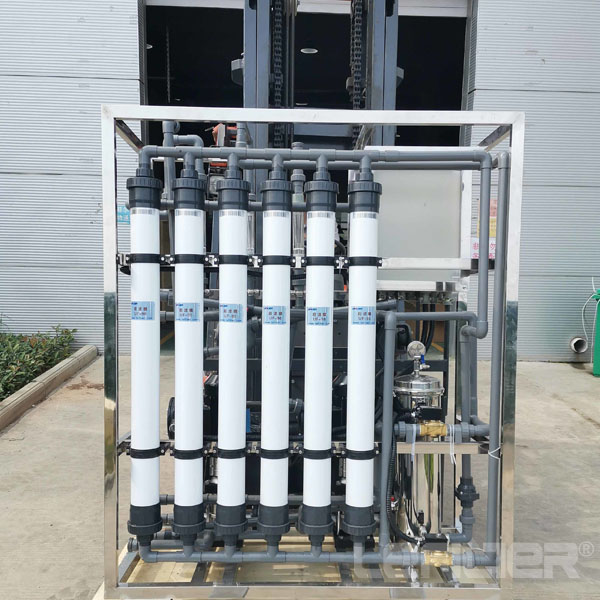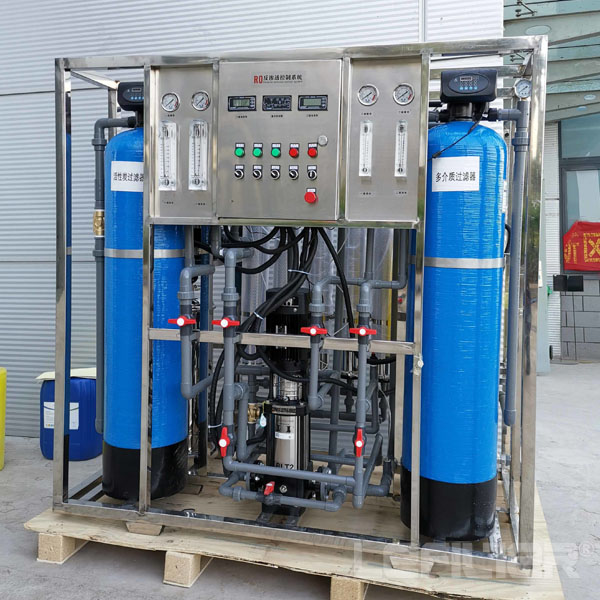2021-07-19

The process of pure water treatment includes coarse filtration, fine filtration, ultrafiltration, reverse osmosis, ion exchange, EDI, etc. Today we will focus on the meaning of the first four
1. Pre- filtration
Coarse filtration: refers to mechanical filtration to remove suspended solids, colloids, turbidity, chroma, peculiar smell, etc. in water. The main filtering methods are clarifier, fast filter, sand filter, sand filter, multi-media filter, activated carbon filter, disc filter, high efficiency fiber filter, etc.
2. Fine filtration
Fine filtration: a filter membrane made of special materials with high filtration accuracy. The common ones are microfiltration membrane and filter element filtration.
3.Ultrafiltration
Ultrafiltration: It is a kind of membrane filtration that removes macromolecules, colloids, bacteria, etc. The filtration accuracy is high, and the most common is ultrafiltration membrane. Ultrafiltration membrane cannot remove ions in water, that is, it has no salt removal function. It is used for reverse osmosis pretreatment or finishing after reverse osmosis, and can also be used alone. Ultrafiltration is a filtration process driven by tangential fluid flow and pressure, and particles are separated according to their molecular weight. The pore size of the ultrafiltration membrane is approximately in the range of 0.002-0.1 microns. Dissolved substances and substances smaller than the pore size of the membrane can be used as permeate to pass through the filtration membrane, and substances that cannot pass through the filtration membrane are concentrated in the discharge liquid. Therefore, the produced water contains water, dissolved solids and small molecular weight substances, while colloids, suspended particles, high molecular weight organic matter, bacteria, viruses and protozoa will be filtered out.
4. Reverse osmosis
Reverse osmosis: RO, abbreviated as RO, is a membrane separation technology developed in the 1960s. The principle is that raw water passes through the reverse osmosis membrane under high pressure, and the solvent in the water diffuses from high concentration to low concentration to achieve separation. For the purpose of purification and concentration, it is called reverse osmosis because it is opposite to the direction of natural permeation. Reverse osmosis can remove bacteria, viruses, colloids, organic matter and more than 98% of soluble salts in water. The method has the characteristics of low operating cost, simple operation, high degree of automation, and stable effluent quality. Compared with other traditional water treatment methods, it has obvious advantages and is widely used in various industries related to water treatment. The reverse osmosis water treatment process is basically a physical desalination method, and it has excellent characteristics that traditional water treatment methods do not have in many aspects:
a. Reverse osmosis is to remove salt and purify salt-containing feed water by using a physical method without phase change at room temperature. At present, the salt removal rate of ultra-thin composite membrane elements can reach more than 99.5%, and can simultaneously remove colloids, organic matter, bacteria, viruses, etc. in water.
b. Water treatment only relies on water pressure as the driving force, and its energy consumption is the lowest among many treatment methods.
c. There is no need for a large amount of chemical agents and acid and alkali regeneration treatment, no chemical waste liquid discharge, and no environmental pollution.
d. The reverse osmosis device can run continuously to produce water, the system is simple, the operation is convenient, and the product water quality is stable.
e. The reverse osmosis device has a high degree of automation, and the workload of operation and maintenance and equipment maintenance is small.
f. The equipment occupies a small area and the space required is also small
g. It is suitable for a wide range of raw water quality, not only for the treatment of brackish water, sea water and even sewage, but also for the treatment of fresh water with low salinity. Our company has many years of experience in industrial water treatment system process design, equipment manufacturing, system complete sets and membrane application technology, and selects reasonable process settings and design parameters to ensure long-term stable operation of the equipment.
